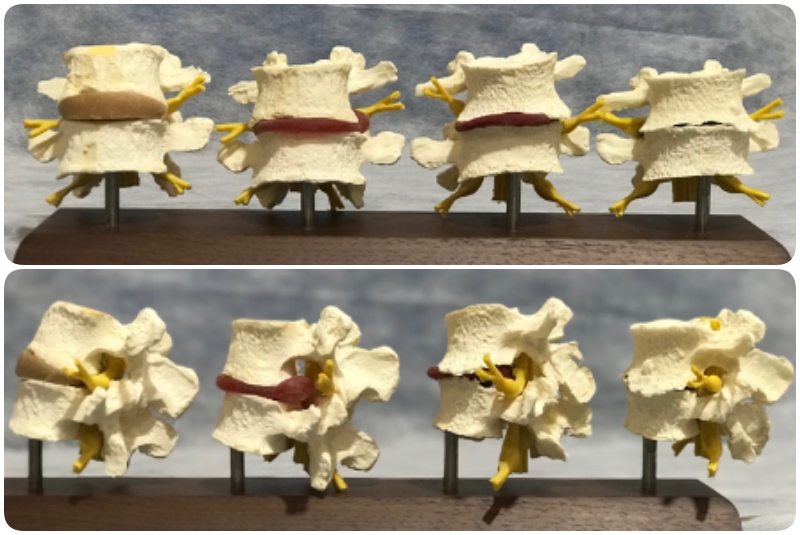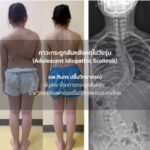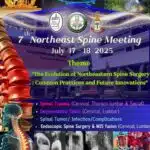Lumbar disc degeneration
(Lumbar Degenerative Disc Disease)
Chapter 1: Causes and symptoms of the disease
Dr. Chaiyuth Suthirayongprasit
Spine Division, Royal College of Orthopaedic Surgeons of Thailand
What is lumbar disc degeneration?
Lumbar disc degeneration is one of the main causes of back pain. At the same time, it is a cause that current medicine cannot clearly analyze the mechanism of how it occurs. We only try to separate and categorize and initially conclude that it is a group of symptoms or process of deterioration (wear and tear) of the spinal discs that occurs with age (age related) and leads to back pain.
Therefore, we must first provide some basic information to create understanding about what normal intervertebral discs look like before they start to deteriorate. The structure of the human spine is normally similar to a snake’s bone, consisting of short bones connected by one intervertebral disc and one pair of small joints. It is like this from the neck to the buttocks. Inside each bone, there is a hole that goes through it like a conduit for electrical wires. This conduit actually contains the spinal cord and nerve roots that send nerves to the arms, legs, and other organs. When humans stand upright, this means that our spine is vertically upright. Therefore, the force from our body weight is transmitted through the spine and then through the legs. Furthermore, humans can bend, tilt, and twist their bodies. Therefore, the spine, which is the core of the body, must also change shape according to the body’s postures. This requires forces in various directions through the spine. In reality, the hard bone part of the spine is fixed and cannot be adjusted. Therefore, the burden of adjusting the shape and conforming to the body’s postures falls on the intervertebral disc, which is soft tissue. At this point, we understand that the intervertebral discs are an important part in receiving and transmitting forces in various directions that occur in the spine. They act as shock absorbing rings between the vertebrae and are the parts that allow the body to adjust its shape according to the body's postures.
The intervertebral disc is a solid, oval-shaped disc, approximately 1 centimeter thick. The outer shell is a fibrous tissue such as collagen, tightly packed in layers like an onion. The inner part is soft, jelly-like. When combined, they can act as a shock-absorbing ring that can hold the vertebrae together, transmit force, and flex when the spine moves. And this is the normal appearance and function of a complete intervertebral disc.

Symptoms of lumbar disc degeneration
When the degeneration of the spinal disc occurs, the patient will experience pain in the lower back area, which is usually not very severe. The pain comes and goes and is bearable. There may be pain radiating to the hips, groin or nearby thighs. The muscles in these areas may become tight and sore.
Patients may notice that when sitting for a long time and then changing positions to stand up, the pain is worse. Sitting leaning back with a pillow to support the body is less painful than sitting upright. Changing positions frequently, sitting, standing, or taking short walks, reduces the pain.
There may be times when the pain may flare up severely for days or weeks and then subside.
If the disc is severely degenerated, the patient may experience sudden severe pain when changing positions or may feel weak and collapse.
Normally, if the spinal discs are not severely deteriorated to the point of collapsing and pressing on the nerves, the patient will not have pain radiating down the legs, leg numbness, or symptoms that interfere with urination or defecation control.
Causes and risk factors
Degeneration of the intervertebral discs definitely occurs with age. There may be precipitating factors such as accidents that happen to the spine, a life with high-intensity activities or activities that require frequent and rapid movement of the spine. Some people may have genetic factors that cause problems with the body's structural-joint system. Often, there may be a combination of factors, or sometimes the contributing factors may not be clearly identified.
As a disc degenerates, it loses its blood and nutrient supply due to narrowing of the pores that allow blood to flow from the adjacent vertebrae. The jelly-like substance inside the disc loses its elasticity and becomes more rigid. The outer covering of the disc tears and separates.
When a disc degenerates, a person will experience back pain because proteins leak out of the disc through the tear in the disc membrane. This protein causes inflammation when it comes in contact with the nerves that surround the disc. In addition, pain is caused by the instability - the micro-movement or dislocation - of the vertebral body attached to the degenerated disc.
Normally, back pain after degenerative disc disease will gradually subside over time as the protein is released and some of the discs become degenerative until the vertebrae start to fuse together and there is no movement at all.
Risk factors found to be linked to degenerative disc disease
1. Family history of back pain or bone and joint problems.
2. Minor injuries to the back muscles accumulated from playing sports, lifting heavy objects, or physical labor.
3. Tension builds up in the intervertebral discs from occupations that require long periods of sitting or in improper postures.
4. Weak back and abdominal muscles
5. Fat people
6. Smoking







